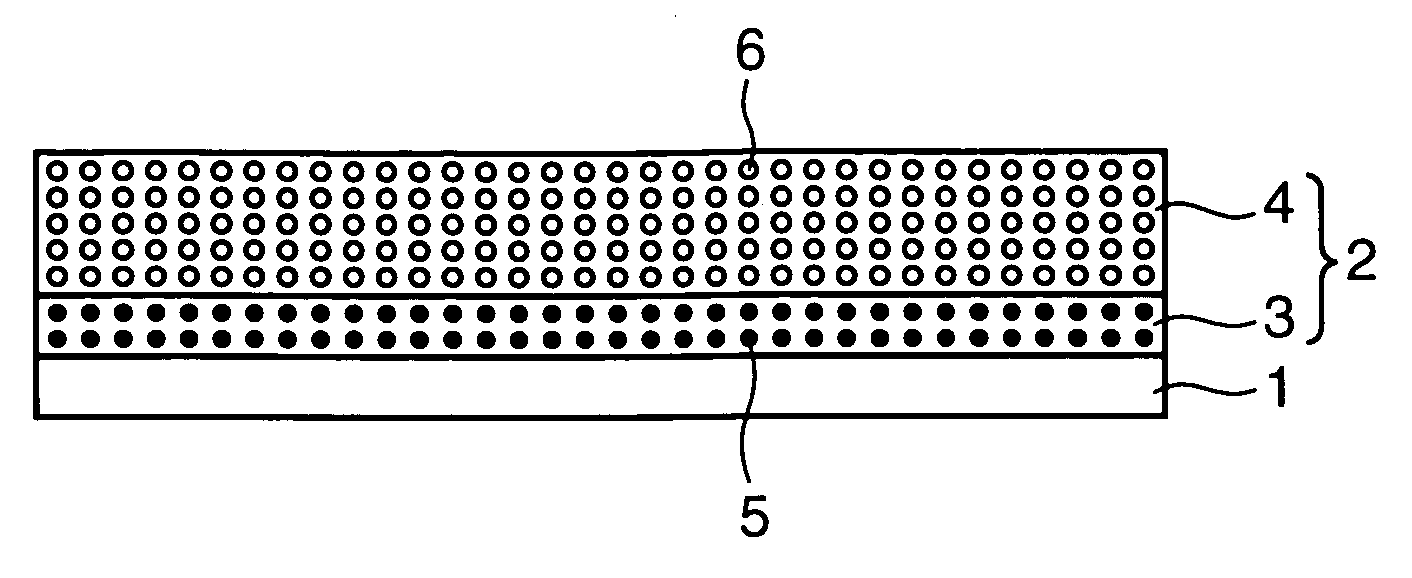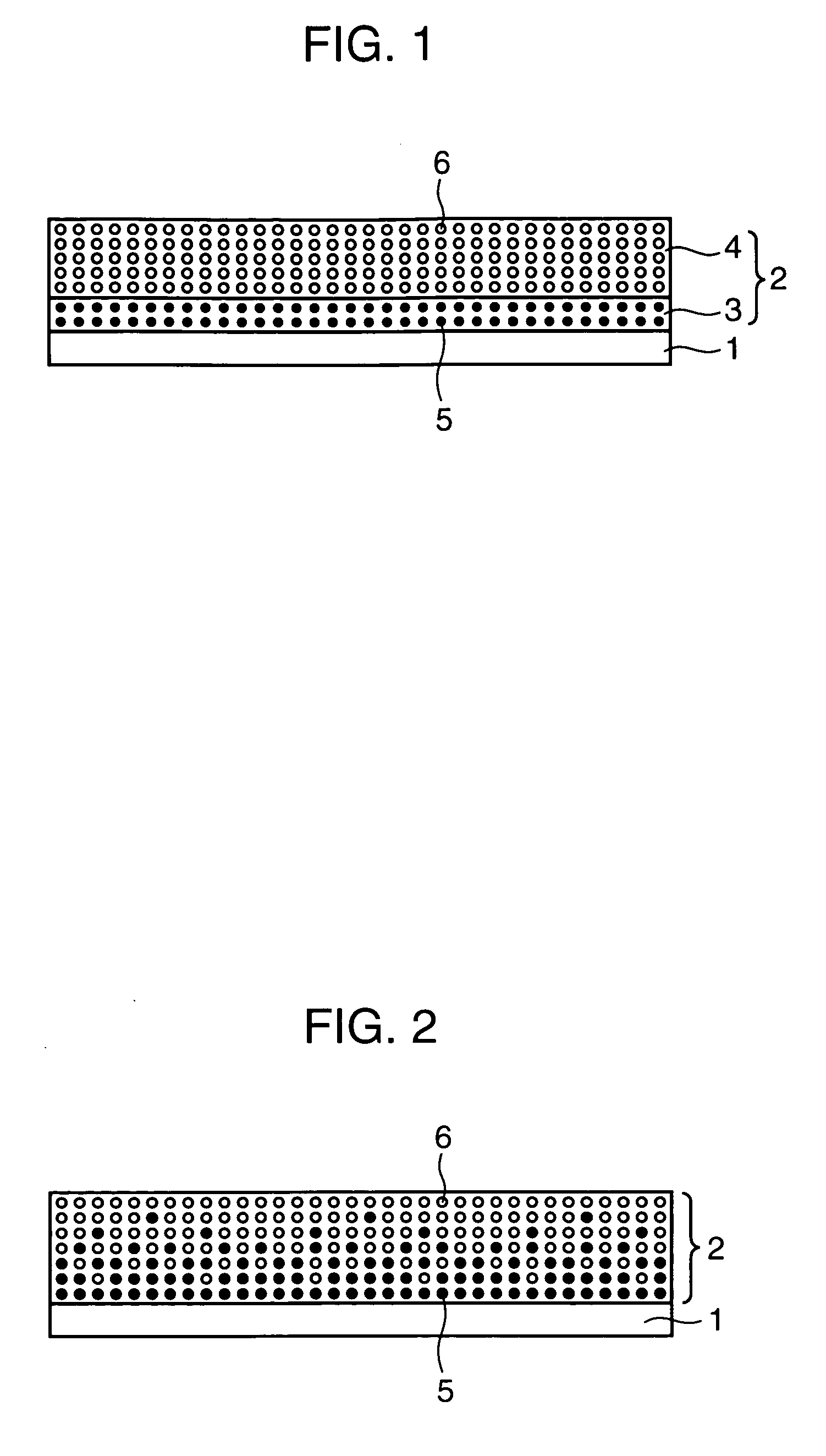Positive electrode for lithium secondary battery, and lithium secondary battery using the same
a lithium nickel oxide and secondary battery technology, applied in the direction of cell components, final product manufacturing, sustainable manufacturing/processing, etc., can solve the problems of overheating the battery, lithium secondary batteries using lithium nickel oxide as the positive electrode active material tend to be overheated, and overheating the battery, etc., to achieve the effect of easy formation
- Summary
- Abstract
- Description
- Claims
- Application Information
AI Technical Summary
Benefits of technology
Problems solved by technology
Method used
Image
Examples
first embodiment
[0023] A positive electrode according to a first embodiment of the invention, for use in a lithium secondary battery, comprises a positive electrode current collector, and a positive electrode film which is carried on the positive electrode current collector and includes plural mixture layers. The positive electrode film contains, as a positive electrode active material, two or more kinds of lithium-containing compounds having exothermic initiation temperatures different from each other. At least one kind of the two or more kinds of lithium-containing compounds has the exothermic initiation temperature of 300° C. or higher, and a first mixture layer of the plural mixture layers, which is closest to the positive electrode current collector, contains at least one kind of lithium-containing compound having the exothermic initiation temperature of 300° C. or higher.
[0024] The positive electrode according to the first embodiment is described referring to FIG. 1.
[0025]FIG. 1 is a schema...
second embodiment
[0060] A positive electrode, for use in a lithium secondary battery, according to a second embodiment of the invention has features that a positive electrode film to be carried on a positive electrode current collector contains, as a positive electrode active material, two or more kinds of lithium-containing compounds having exothermic initiation temperatures different from each other, at least one kind of the two or more kinds of lithium-containing compounds has the exothermic initiation temperature of 300° C. or higher, and a content of the lithium-containing compound having the exothermic initiation temperature of 300° C. or higher is increased in a thickness direction of the positive electrode film from an outermost layer of the positive electrode film toward the positive electrode current collector.
[0061] The positive electrode according to the second embodiment is described referring to FIG. 2. Since the positive electrode current collector and the positive electrode active m...
examples
[0073] (i) Preparation of Positive Electrode Active Material
[0074] Positive electrode active materials a-1 through a-6 were prepared by the following processes (i-1) through (i-6), respectively.
[0075] (i-1) Preparation of Positive Electrode Active Material a-1
[0076] Li2CO3 and CoCO3 were mixed with a predetermined molar ratio, the mixture was sintered at 900° C. for 10 hours, followed by pulverization and sorting. Thus, the positive electrode active material a-1 represented by the chemical formula: LiCoO2 was yielded.
[0077] (i-2) Preparation of Positive Electrode Active Material a-2
[0078] An aqueous solution containing cobalt sulfate with a concentration of 0.98 mol / L, and magnesium sulfate with a concentration of 0.02 mol / L was continuously fed to a reaction tank, and sodium hydroxide was added dropwise to the reaction tank so that pH of the aqueous solution was in the range of 10 to 13, whereby a precursor active material was synthesized. The precursor active material was suf...
PUM
| Property | Measurement | Unit |
|---|---|---|
| temperature | aaaaa | aaaaa |
| thickness | aaaaa | aaaaa |
| thickness | aaaaa | aaaaa |
Abstract
Description
Claims
Application Information
 Login to View More
Login to View More - R&D
- Intellectual Property
- Life Sciences
- Materials
- Tech Scout
- Unparalleled Data Quality
- Higher Quality Content
- 60% Fewer Hallucinations
Browse by: Latest US Patents, China's latest patents, Technical Efficacy Thesaurus, Application Domain, Technology Topic, Popular Technical Reports.
© 2025 PatSnap. All rights reserved.Legal|Privacy policy|Modern Slavery Act Transparency Statement|Sitemap|About US| Contact US: help@patsnap.com


